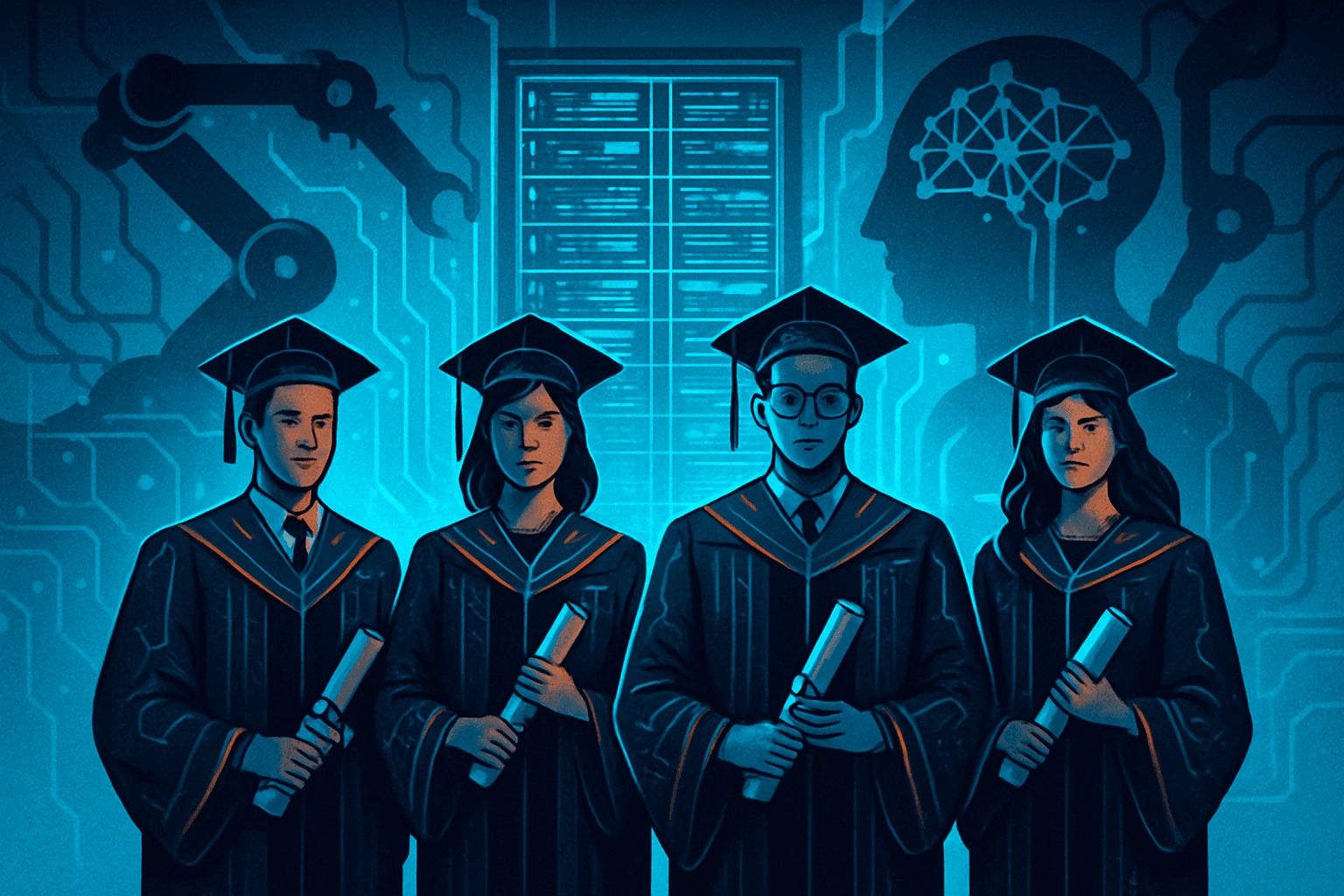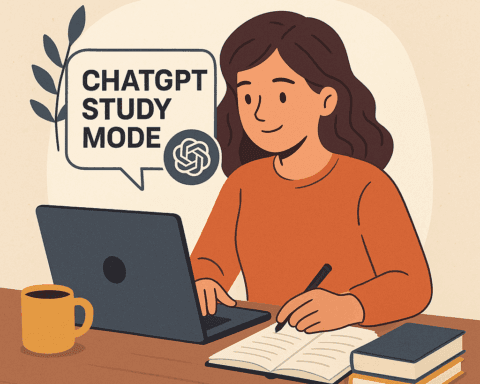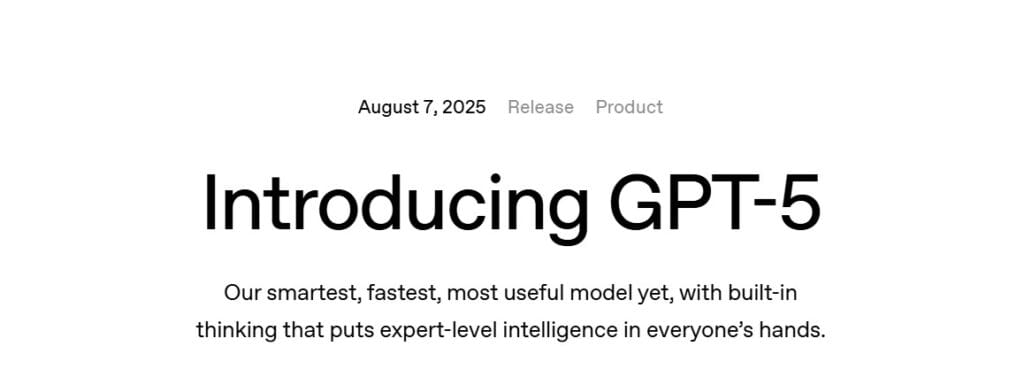Last Updated on August 18, 2025 7:30 pm by Laszlo Szabo / NowadAIs | Published on August 18, 2025 by Laszlo Szabo / NowadAIs
Unemployment Due to AI: Are College Degrees Still Worth It? – Key Notes
Unemployment due to AI is rising fastest among young, tech-exposed graduates, with automation shrinking entry-level job opportunities across multiple sectors.
While AI-driven industries are creating new careers, reskilling remains a significant challenge, leaving many workers unable to transition quickly enough.
The impact of unemployment due to AI is felt unevenly across countries and majors, forcing students, professionals, and policymakers to adapt strategies for a changing workforce.
Graduates and the Shifting Job Landscape
The digital transformation sweeping through global economies is rattling old assumptions about job security, particularly for those with university degrees. While higher education was once considered a ticket to stable employment, the growing effect of artificial intelligence is causing many to rethink the value and future-proofing of their hard-earned diplomas.
AI’s March Into White-Collar Work
Until recently, most professionals believed that automation would hit routine and manual jobs hardest. Cashiers, assembly line workers, and call center operators felt the earliest tremors. Today, the story of unemployment due to AI is changing. White-collar jobs in areas such as legal analysis, accounting, translation, and software engineering are now confronting unprecedented risks. Generative AI platforms, like ChatGPT and their corporate cousins, analyze contracts, draft reports, and even write code with efficiency that can rival or outpace newly graduated talent (Source: fortune.com).
The Shift in Graduate Unemployment Patterns
In 2025, unemployment among college-educated Americans aged 22 to 27 hit its highest level in four years, reaching 5.8% (Source: fortune.com). While slowing economies play a role, the adoption of AI-driven tools for entry-level work is rapidly shrinking available opportunities. Recent research reveals that the unemployment rate for younger workers in tech-exposed fields rose by 3 percentage points in just a few months (Source: goldmansachs.com). The prospects for graduates in graphic design, industrial engineering, and even architecture are all altered by the wide embrace of AI, according to J.P. Morgan’s analysis (Source: jpmorgan.com).
Increasingly, freshly minted professionals and graduates with little experience find themselves in competition not just with peers but with machine learning algorithms and sophisticated automation workflows. As AI tools become cheaper and easier to integrate, entry-level positions are consolidated or eliminated.
Industrial Sectors Most at Risk
Globally, administrative support and data entry roles are at the highest risk from unemployment due to AI, with hiring rates plunging by 45% since 2022 (Source: sqmagazine.co.uk). Logistics, manufacturing, and even retail are experiencing rapid workforce reductions as AI platforms master processes that once required squads of human workers. In one reported case, a logistics manager watched his department shrink from 28 people to just five over six months because of system upgrades.
Finance and legal services aren’t immune. Thanks to advances in natural language processing and automation, firms can delegate monotonous and repetitive tasks—such as auditing, compliance monitoring, and portfolio tracking—to AI systems, further squeezing out entry-level human jobs.
Job Creation: Fact or Fantasy?
It’s important to note that, despite the headlines about unemployment due to AI, not all forecasts are gloomy. The World Economic Forum projects 85 million jobs will disappear by the end of 2025 due to automation—especially through AI—but also expects 97 million new roles to be created (Source: sqmagazine.co.uk). These are mostly in tech: digital marketing, cybersecurity, software development, and AI training. In the US, 320,000 new AI-dependent jobs were filled in 2024, many offering impressive salaries.
Still, this silver lining is not evenly distributed. Only 36% of displaced workers globally have been able to shift into new AI professions, revealing persistent obstacles in retraining, reskilling, and access to digital education. Workers in traditional industries and those in regions with lower technological infrastructure face longer adjustment periods and fewer new opportunities.
Global Trends and the Skills Gap
The effects of unemployment due to AI are more severe in places with advanced IT infrastructure—Japan, South Korea, Germany, and the United States see higher rates of displacement than Africa or Latin America (Source : sqmagazine.co.uk). In China, an astonishing 77% of jobs may be susceptible to automation. Europe expects to lose or fundamentally transform 12 million roles within three years.
At the same time, the labor market is seeing explosive growth in new specialties—AI trainers, prompt engineers, digital content overseers, and compliance experts. These positions did not exist a few years ago, but their demand is rising fast. The challenge for society is matching displaced workers with the requirements of new roles, especially where practical retraining resources lag behind technological expansion.
The College Major Dilemma

Anthropology graduates, traditionally less exposed to technology, continue to face steep competition for jobs, but even graduates in computer engineering, graphic design, and architecture have witnessed rising unemployment due to AI. J.P. Morgan researchers highlight that as AI performs ever more complex tasks, new entrants from these majors are disadvantaged, even compared to those with experience whose skills may be slightly outdated (Source: jpmorgan.com).
Similarly, fields once regarded as recession-proof—engineering, medicine, law—are now being reexamined. Non-routine cognitive occupations, such as scientists and researchers, are increasingly exposed to risks that manual workers once faced during automation booms of previous decades.
Repercussions for the Young and Entry-Level Workforce
While total unemployment figures have not reached apocalypse levels, the market squeeze for new workers is very real. Today, younger workers are disproportionately affected, with some entry-level positions for college graduates declining far below pre-pandemic trends. Employers increasingly opt for automation in roles that require minimal supervision or can be standardized by software.
Barrier to entry isn’t simply about the degree anymore; it’s about a unique blend of adaptability, tech-savviness, and willingness to continuously learn. Employers want resilient workers who can seamlessly collaborate with digital systems. As a result, unemployment due to AI is forcing changes not only in hiring but in education: more universities are pivoting to curricula that focus on AI fluency, ethics, and digital literacy.
Reskilling and Hope for the Future
Major corporations—Amazon, IBM, and Google among them—have invested heavily in reskilling programs, aiming to help employees keep up with the AI-driven job market. Over $1.2 billion has been funneled into cloud computing and AI certification initiatives, but the bottleneck persists: demand for these roles regularly outpaces supply of qualified candidates (Source: sqmagazine.co.uk).
Those who do manage to transition often find themselves in more dynamic, better-paying jobs. The cybersecurity market alone is projected to create 3.5 million new jobs globally by 2025, propelled by AI. Edtech and healthtech also offer substantial opportunities for new arrivals willing to embrace change.
The Human Perspective: Anxiety and Adaptation
Unemployment due to AI is not only an economic phenomenon—it’s personal. Many workers and graduates struggle with the psychological impact of uncertainty, wondering if their expertise will soon be obsolete or replaced by an algorithm. The discomfort often manifests as resistance to adopting new tools, skepticism toward retraining programs, or even departure from the labor force altogether.
But human ingenuity remains a valuable asset. AI-driven economies value creative problem-solving, emotional intelligence, and adaptability. Workers who retrain and shift to new career paths can continue building successful futures, though the transition may be rocky.
How to Prepare for the New Reality?
Facing unemployment due to AI requires a multipronged approach. As industries and jobs transform, adaptability is no longer a bonus—it’s essential. Lifelong learning, willingness to reskill, and openness to interdisciplinary roles will provide the best buffers against disruption. Governments and education providers are under pressure to respond with meaningful reforms, but individuals must take the lead wherever possible.
Definitions
Unemployment due to AI: Job loss or reduction in employment opportunities as companies replace human roles with artificial intelligence or automation.
Automation: The use of technology—including AI—to perform tasks without human intervention.
Reskilling: Training workers in new skills needed for jobs created or transformed by AI.
Entry-level position: A job requiring little or no prior professional experience, usually for graduates or those new to an industry.
Non-routine cognitive occupation: A job defined by mental work (problem-solving, designing, analyzing) versus manual routines; often high-skilled.
Frequently Asked Questions (FAQ)
- Why are graduates most affected by unemployment due to AI? Graduates often seek entry-level positions requiring routine or repetitive tasks, which are easily automated by AI. As more businesses implement AI solutions and automation, these jobs decline rapidly. Many employers prefer experienced candidates who adapt quickly to new systems, leaving recent graduates at a disadvantage. The impact of unemployment due to AI can be profound for new professionals trying to start their careers.
- What kinds of jobs are considered most vulnerable to unemployment due to AI? Jobs with repetitive and predictable responsibilities—like administrative support, data entry, logistics, and some engineering or design roles—face the highest risk from automation. Unemployment due to AI also increasingly affects white-collar fields where algorithms can match or surpass human performance. Manual labor, creative arts, and customer relations may remain safer for longer, but digital skills are vital across all sectors.
- Can reskilling really protect workers from unemployment due to AI? Reskilling is a proven buffer against unemployment due to AI, but it presents challenges. While millions of new jobs arise in tech, cybersecurity, and analytics, only a limited portion of displaced workers move into these fields. Effectiveness depends on government support, corporate investment, and the individual’s willingness to adapt. Ongoing education and flexibility are crucial for navigating the evolving workforce landscape.








